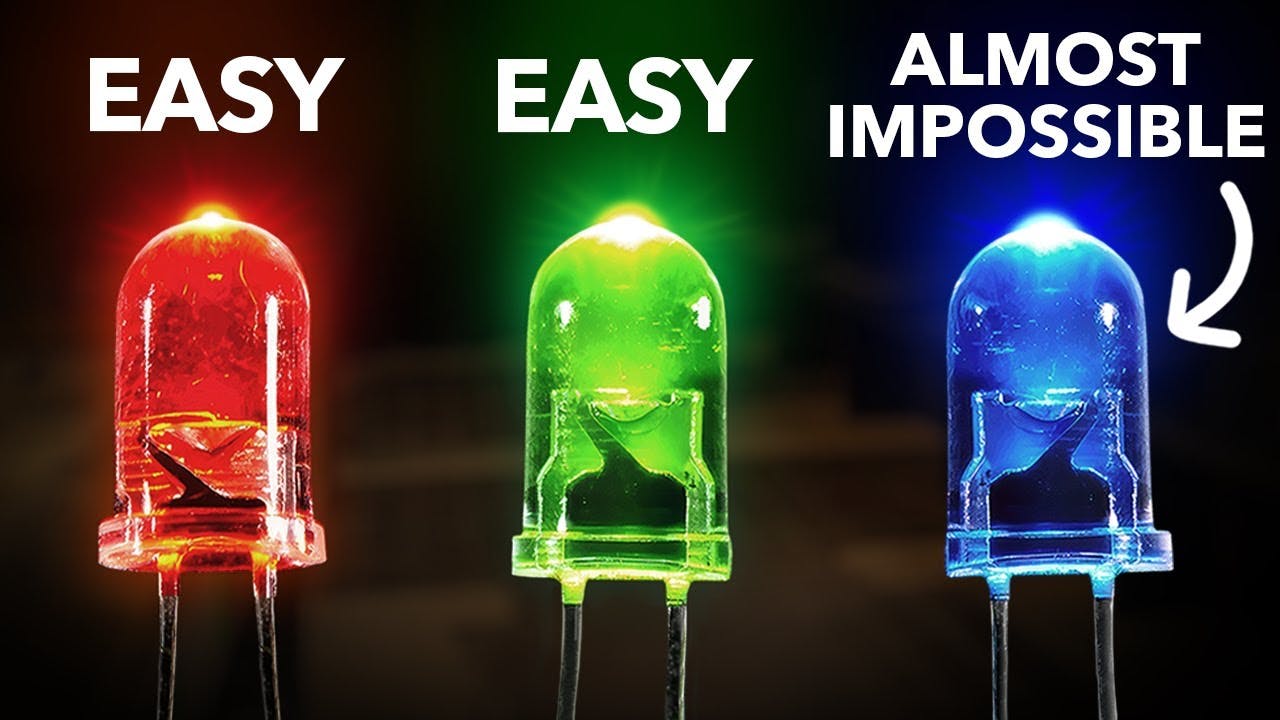Why It Was Almost Impossible to Make the Blue LED
()

History of LEDs
- The first visible LED was created in 1962 by Nick Holonyak, but it was only red.
- For decades, only red and green LEDs were available, limiting their use to indicators, calculators, and watches.
- The blue LED was challenging to create, and despite efforts from major electronics companies, it remained elusive for over 30 years.
- Shūji Nakamura, a researcher at a small Japanese chemical company named Nichia, defied the industry and made three radical breakthroughs to create the world's first blue LED.
- Nakamura's success was due to his persistence and the support of Nichia's founder, Nobuo Ogawa, who invested in his moonshot project.
How LEDs Work
- LEDs get their color from the electronics themselves, not the plastic covers.
- LEDs work by allowing electrons to jump from the valence band to the conduction band, releasing energy as photons of light.
- The size of the band gap determines the color of the light emitted by an LED.
Nakamura's Breakthroughs
- Nakamura's initial proposal to Ogawa involved mastering MOCVD (Metal Organic Chemical Vapor Deposition) in Florida to create high-quality crystal for blue LEDs.
- After returning to Japan, Nakamura focused on gallium nitride despite its challenges, including difficulties in crystal growth and p-type doping, while most researchers favored zinc selenide.
- Nakamura's breakthrough came when he developed the two-flow MOCVD reactor, which improved the quality of gallium nitride crystals by preventing the formation of powdery waste.
- He created the world's first p-type gallium nitride by heating magnesium-doped gallium nitride to 400 degrees Celsius, a process known as annealing.
- Nakamura created an indium gallium nitride crystal by adjusting his MOCVD reactor to pump as much indium as he could onto the gallium nitride.
- Nakamura fixed the issue of electron overflow by creating a "hill" structure in the LED.
Commercialization of Blue LEDs
- Nichia called a press conference in Tokyo to announce the world's first true blue LED, which had a light output power of 1,500 microwatts and emitted a perfect blue at exactly 450 nanometers.
- Nichia's revenue nearly doubled within three years of introducing the blue LED, and they made the jump from blue to white by placing a yellow phosphor over the LED.
- Nakamura left Nichia in 2000 after more than 20 years at the company and began consulting for Cree, another LED company.
- Nichia sued Nakamura for leaking company secrets, and Nakamura counter-sued Nichia for never properly compensating him for his invention.
- The Japanese courts ruled in Nakamura's favor and ordered Nichia to pay him 10 times his initial request, but Nichia appealed and the case was eventually settled with a payout of $8 million, which only covered Nakamura's legal fees.
Applications of Blue LEDs
- Blue LEDs are now used in various applications, including house lights, streetlights, traffic lights, and displays.
- LED bulbs are more efficient, last longer, are safer to handle, and are completely customizable compared to incandescent or fluorescent bulbs.
- The price of LED bulbs has come down to only a couple of dollars more than other types of bulbs, and they can recoup their cost in only two months with average daily use and electricity pricing.
- LED lighting has revolutionized the lighting industry, with over half of residential lighting sales in the world being LED in 2022.
Nakamura's Current Work
- Shuji Nakamura, the inventor of the blue LED, is now working on the next generation of LEDs, micro LEDs, and UV LEDs.
- Micro LEDs can be used for near-eye displays such as AR and VR.
- UV LEDs could be used to sterilize surfaces and kill pathogens.
- Nakamura is also interested in nuclear fusion and has started a company to develop nuclear fusion technology.
Recognition and Legacy
- Nakamura was awarded the Nobel Prize in physics in 2014 for his work on the blue LED.
- Nakamura's determination, critical thinking, and problem-solving skills set him apart from other researchers working on the blue LED.